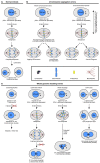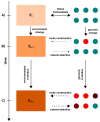Karyotype Aberrations in Action: The Evolution of Cancer Genomes and the Tumor Microenvironment
- PMID: 33921421
- PMCID: PMC8068843
- DOI: 10.3390/genes12040558
Karyotype Aberrations in Action: The Evolution of Cancer Genomes and the Tumor Microenvironment
Abstract
Cancer is a disease of cellular evolution. For this cellular evolution to take place, a population of cells must contain functional heterogeneity and an assessment of this heterogeneity in the form of natural selection. Cancer cells from advanced malignancies are genomically and functionally very different compared to the healthy cells from which they evolved. Genomic alterations include aneuploidy (numerical and structural changes in chromosome content) and polyploidy (e.g., whole genome doubling), which can have considerable effects on cell physiology and phenotype. Likewise, conditions in the tumor microenvironment are spatially heterogeneous and vastly different than in healthy tissues, resulting in a number of environmental niches that play important roles in driving the evolution of tumor cells. While a number of studies have documented abnormal conditions of the tumor microenvironment and the cellular consequences of aneuploidy and polyploidy, a thorough overview of the interplay between karyotypically abnormal cells and the tissue and tumor microenvironments is not available. Here, we examine the evidence for how this interaction may unfold during tumor evolution. We describe a bidirectional interplay in which aneuploid and polyploid cells alter and shape the microenvironment in which they and their progeny reside; in turn, this microenvironment modulates the rate of genesis for new karyotype aberrations and selects for cells that are most fit under a given condition. We conclude by discussing the importance of this interaction for tumor evolution and the possibility of leveraging our understanding of this interplay for cancer therapy.
Keywords: aneuploidy; cancer; karyotype aberrations; niche construction; polyploidy; tetraploidy; tumor ecology; tumor evolution; tumor microenvironment.
Conflict of interest statement
The authors declare no conflict of interest.
Figures



Similar articles
-
Karyotyping of aneuploid and polyploid plants from low coverage whole-genome resequencing.BMC Plant Biol. 2023 Dec 8;23(1):630. doi: 10.1186/s12870-023-04650-9. BMC Plant Biol. 2023. PMID: 38062348 Free PMC article.
-
Proliferative advantage of specific aneuploid cells drives evolution of tumor karyotypes.Biophys J. 2023 Feb 21;122(4):632-645. doi: 10.1016/j.bpj.2023.01.017. Epub 2023 Jan 18. Biophys J. 2023. PMID: 36654508 Free PMC article.
-
Chromosome-scale mega-haplotypes enable digital karyotyping of cancer aneuploidy.Nucleic Acids Res. 2017 Nov 2;45(19):e162. doi: 10.1093/nar/gkx712. Nucleic Acids Res. 2017. PMID: 28977555 Free PMC article.
-
The consequences of tetraploidy and aneuploidy.J Cell Sci. 2008 Dec 1;121(Pt 23):3859-66. doi: 10.1242/jcs.039537. J Cell Sci. 2008. PMID: 19020304 Review.
-
Advances in the detection of chromosomal aberrations using spectral karyotyping.Clin Genet. 2001 Feb;59(2):65-73. doi: 10.1034/j.1399-0004.2001.590201.x. Clin Genet. 2001. PMID: 11260203 Review.
Cited by
-
Whole-Genome Duplication Shapes the Aneuploidy Landscape of Human Cancers.Cancer Res. 2022 May 3;82(9):1736-1752. doi: 10.1158/0008-5472.CAN-21-2065. Cancer Res. 2022. PMID: 35502547 Free PMC article.
-
Pan-Cancer Analysis and Experimental Validation Identify ACOT7 as a Novel Oncogene and Potential Therapeutic Target in Lung Adenocarcinoma.Cancers (Basel). 2022 Sep 18;14(18):4522. doi: 10.3390/cancers14184522. Cancers (Basel). 2022. PMID: 36139682 Free PMC article.
-
Constitutive Activation of the Tumor Suppressor p53 in Hepatocytes Paradoxically Promotes Non-Cell Autonomous Liver Carcinogenesis.Cancer Res. 2022 Aug 16;82(16):2860-2873. doi: 10.1158/0008-5472.CAN-21-4390. Cancer Res. 2022. PMID: 35696550 Free PMC article.
-
Machine Learning: A New Prospect in Multi-Omics Data Analysis of Cancer.Front Genet. 2022 Jan 27;13:824451. doi: 10.3389/fgene.2022.824451. eCollection 2022. Front Genet. 2022. PMID: 35154283 Free PMC article. Review.
-
Tracking circulating PD-L1-positive cells to monitor the outcome of patients with gastric cancer receiving anti-HER2 plus anti-PD-1 therapy.Hum Cell. 2024 Jan;37(1):258-270. doi: 10.1007/s13577-023-00990-8. Epub 2023 Oct 27. Hum Cell. 2024. PMID: 37889437 Free PMC article.
References
-
- Klughammer J., Kiesel B., Roetzer T., Fortelny N., Nemc A., Nenning K.-H., Furtner J., Sheffield N.C., Datlinger P., Peter N. The DNA methylation landscape of glioblastoma disease progression shows extensive heterogeneity in time and space. Nat. Med. 2018;24:1611–1624. doi: 10.1038/s41591-018-0156-x. - DOI - PMC - PubMed
Publication types
MeSH terms
LinkOut - more resources
Full Text Sources
Other Literature Sources
Medical

